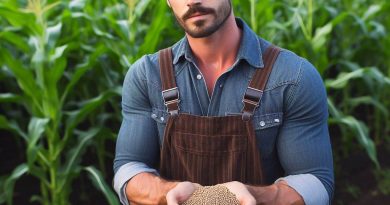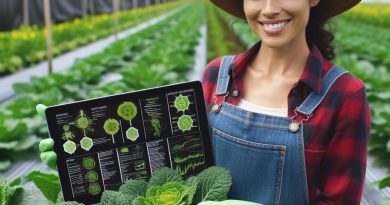Efficient Cotton Picking Methods Explained
Last Updated on February 6, 2024
Introduction
Importance of efficient cotton picking methods
Efficient cotton picking methods are vital for the success of cotton production. This blog section provides an overview of the importance of these methods and the process of cotton harvesting.
Brief overview of cotton production and harvesting process
Cotton farming plays a significant role in the textile industry as cotton is a widely used natural fiber. The process begins with planting the cotton seeds, followed by nurturing the plants until they mature.
Once the cotton bolls have formed, they are ready for harvesting. Efficient picking methods contribute to maximizing yield and reducing labor costs.
Traditional handpicking, requiring skilled labor, is time-consuming and expensive. However, technological advancements have introduced more efficient options.
One such method is mechanical harvesting, which involves the use of specialized machines that mechanically remove the cotton bolls from the plants.
These machines use spinning spindles or brushes to rapidly collect the cotton, with the fibers being separated from the seeds later in the ginning process.
Mechanical picking significantly increases productivity, saving both time and labor compared to manual harvesting. It also ensures a cleaner yield, minimizing contamination.
Another approach is the use of cotton strippers, which are machines that strip the entire plant of its cotton bolls, including the leaves and stems.
While this method is faster than handpicking, it requires additional steps to separate the cotton from the plant debris.
Choosing the appropriate picking method depends on various factors such as field conditions, labor availability, and overall productivity goals.
Basically, efficient cotton picking methods are crucial for the cotton industry’s success. Technological advancements have revolutionized the cotton harvesting process, allowing for increased productivity and reduced costs.
Traditional Hand Picking
Manual cotton picking process
Hand picking involves laborers manually harvesting cotton by plucking the cotton bolls from the plants.
The process begins with workers carefully inspecting the cotton plants for mature bolls.
Once identified, the workers use their hands to gently detach the cotton bolls from the plant.
The plucked cotton bolls are then collected in baskets or sacks, ready for further processing.
Advantages of hand picking
Hand picking allows for selective harvesting, ensuring only mature bolls are collected.
This method avoids gathering unripe cotton, resulting in higher-quality fibers for textile production.
Manual picking also reduces the risk of damaging the cotton plant, preserving its future productivity.
Additionally, hand picking enables workers to identify and remove any contaminated or damaged cotton bolls.
Disadvantages of hand picking
One major drawback of hand picking is its labor-intensive nature, demanding a considerable workforce.
Due to the manual labor involved, hand picking can be time-consuming and costly on a large scale.
Another disadvantage is the potential for lower efficiency compared to mechanized harvesting methods.
Manual picking also places physical strain on workers, causing fatigue and potential health issues.
Use of labor-intensive methods in certain regions
In some regions, particularly developing countries, hand picking remains the dominant cotton harvesting method.
These regions often lack the infrastructure and resources necessary for mechanized picking.
Additionally, socio-economic factors may contribute to the prevalence of hand picking, such as high unemployment rates.
Hand picking provides employment opportunities for local communities, supporting their livelihoods.
Despite its limitations, hand picking continues to be practiced due to its unique advantages and regional circumstances. Efforts are being made to improve the efficiency of hand picking through training programs and technological advancements.
For example, training workers to identify mature bolls more accurately can enhance productivity. Furthermore, implementing ergonomic tools and equipment can help reduce physical strain on laborers
In fact, although manual hand picking is a labor-intensive method, it offers specific advantages and is still widely practiced in certain regions.
The selective harvesting and preservation of fiber quality make it an attractive option for ensuring superior cotton fibers. However, the high costs, inefficiency, and physical strain associated with hand picking highlight the need for alternative, more efficient methods.
As the cotton industry progresses, advancements in technology and machinery can help mitigate these challenges, leading to more sustainable and efficient cotton harvesting practices.
Read: Post-Harvest Grain Storage: Essential Guide
Mechanical Cotton Picking
Introduction to mechanical cotton picking machines
With the advancement of technology, cotton picking has become more efficient and less labor-intensive.
Mechanical cotton picking machines have revolutionized the cotton industry.
How these machines work
Mechanical cotton pickers use a combination of suction, spindles, and brushes to harvest cotton.
They are equipped with rotating spindles that pull the cotton from the plant and deposit it into a collecting basket.
Suction is used to keep the cotton in place during the picking process.
Advantages and disadvantages compared to hand picking
Mechanical cotton picking machines have significantly increased efficiency and productivity.
They can harvest a larger amount of cotton in a shorter period of time compared to hand picking.
These machines are also beneficial in terms of reducing labor costs and increasing profitability.
However, mechanical picking can sometimes result in lower cotton quality due to damage caused by the machines.
Hand picking allows for a more precise selection of ripe cotton, resulting in higher-quality fibers.
Different types of mechanical cotton pickers
- Stripper harvesters: These machines strip both the cotton and some of the leaves and stems from the plant.
- Spindle pickers: These machines grasp the cotton with rotating spindles and remove it from the plant.
- Cotton combines: These machines combine the functions of stripping and spindle picking.
To summarize, mechanical cotton picking machines have revolutionized the cotton industry by increasing efficiency and productivity.
With the use of suction, spindles, and brushes, these machines can harvest a larger amount of cotton in less time compared to hand picking.
However, there are advantages and disadvantages to mechanical picking. While it reduces labor costs and increases profitability, it can sometimes result in lower cotton quality.
Different types of mechanical cotton pickers, such as stripper harvesters, spindle pickers, and cotton combines, offer various options for farmers to choose from based on their specific needs and preferences.
Overall, the adoption of mechanical cotton picking has significantly transformed the cotton industry and continues to play a crucial role in modern cotton farming.
Read: Optimal Soybean Harvesting: When & How
Impact of Technological Advancements on Cotton Picking Efficiency
In recent years, the cotton industry has witnessed significant advancements in technology that have revolutionized the efficiency of cotton picking.
These advanced technologies have made the entire process faster, more precise, and less labor-intensive. Let’s explore some of the key technological advancements used in cotton picking and the impact they have had.
Introduction to Advanced Technologies Used in Cotton Picking
Traditional cotton picking methods involved manual labor, which was time-consuming and often resulted in yield losses. However, with the introduction of advanced technologies, cotton picking has become much more efficient.
GPS Systems for Precision Picking
One of the key technologies that have revolutionized cotton picking is the use of GPS systems. These systems are integrated with cotton pickers, allowing farmers to precisely navigate through the fields.
GPS-enabled cotton pickers can automatically adjust their speed and position, ensuring every cotton boll is picked efficiently.
The use of GPS systems in cotton picking has several benefits. Firstly, it minimizes waste by preventing damage to unripe cotton bolls.
Secondly, it increases productivity as pickers can cover larger areas in less time. The precision provided by GPS also ensures higher-quality cotton harvests.
Use of Robotics and Artificial Intelligence in Cotton Picking
Another technological advancement that is transforming cotton picking is the integration of robotics and artificial intelligence (AI). Robotic cotton pickers, equipped with AI algorithms, are capable of identifying ripe cotton bolls with great accuracy.
These robotic pickers use sensors to scan the cotton plants, differentiating between ripe and unripe bolls based on color and size. With their precise picking capability, robotic pickers reduce the likelihood of damaging the plants while ensuring higher yields.
Benefits and Potential Challenges of Technological Advancements
The technological advancements in cotton picking have led to numerous benefits for farmers, workers, and the industry as a whole.
Firstly, these advancements have significantly reduced labor requirements, addressing the issue of labor shortages and lowering production costs.
Furthermore, the increased efficiency and precision in cotton picking have resulted in higher yields and improved product quality. This benefits both farmers and textile manufacturers who rely on high-quality cotton for their products.
However, along with the advantages, there are also potential challenges associated with implementing these technological advancements.
Firstly, the cost of adopting advanced technologies can be a barrier for small-scale cotton farmers. Additionally, the need for training and technical knowledge may pose challenges for some farmers who are not familiar with using such advanced systems.
Moreover, concerns have been raised regarding the potential displacement of human labor due to the use of robotics in cotton picking. While technology can reduce the labor required, it is important to ensure that workers are not left unemployed.
As the cotton industry continues to embrace technological advancements, it should also focus on providing alternative employment opportunities and upskilling programs for affected workers.
In a nutshell, the impact of technological advancements on cotton picking efficiency has been remarkable.
The integration of GPS systems, robotics, and artificial intelligence has transformed the industry, making cotton picking faster, more precise, and less labor-intensive.
While the benefits are evident, it is crucial to address the potential challenges and ensure that the adoption of technology is inclusive and sustainable.
Read: Preventing Soil Erosion Naturally

The Role of Genetics and Breeding in Efficient Cotton Picking
Genetic traits play a crucial role in determining the ease of cotton picking. By understanding and selecting specific traits through breeding, farmers can maximize efficiency and optimize the quality of harvested cotton.
Let’s take a closer look at the significance of genetics and breeding in efficient cotton picking methods.
Genetic traits associated with easy picking
- Fiber quality: Certain genetic traits contribute to the development of longer and stronger cotton fibers, making them easier to pick without breakage.
- Boll size and structure: Cotton varieties with larger bolls and compact structures enable faster picking as they can be easily detached from the plant.
- Open boll characteristics: Genetically modified cotton plants with open and exposed bolls facilitate smooth and efficient picking.
- Reduced vegetative growth: Cotton plants with fewer branches and excessive vegetative growth have a higher chance of tangled bolls, resulting in picking difficulties.
Development of breeds with higher fiber and seed quality
The breeding process involves selecting and crossing cotton plants with desirable traits to produce superior varieties. Breeders focus not only on improving fiber quality but also seed characteristics, which significantly impact cotton picking efficiency.
- Fiber length and strength: Longer and stronger fibers reduce the risk of breakage during picking, leading to higher yields and efficient harvest.
- Seed size and weight: Breeding for larger seeds ensures enhanced germination rates, ultimately maximizing the production of cotton per acre.
- Disease resistance: Developing cotton plants that are resistant to diseases reduces the need for extensive pesticide application, allowing for more efficient picking.
- Fertility and uniformity: Breeds with better fertility and uniform growth enable synchronized maturity, simplifying the picking process.
Impact of selective breeding on reducing picking challenges
Selective breeding has proven to be instrumental in reducing various challenges associated with cotton picking. Improved genetic traits positively influence the efficiency of picking operations in the following ways:
- Enhanced picking rate: By selecting plants with larger bolls and open structures, breeders have been able to increase the picking rate significantly.
- Labor efficiency: Breeding for cotton varieties with reduced boll tangling and stronger fiber strength has reduced labor requirements during pickings.
- Harvest mechanization: Certain breed developments have facilitated cotton picking machine adoption, minimizing manual labor and further improving efficiency.
- Quality optimization: Genetic improvements have helped reduce trash content and contamination during picking, enhancing the overall fiber quality.
Future possibilities for improving cotton picking through genetics
The field of genetics and breeding continues to evolve, offering exciting possibilities for further improving cotton picking efficiency. Here are a few potential advancements:
- Gene editing techniques: Advancements in gene editing technologies like CRISPR/Cas9 hold the potential to precisely modify cotton traits, revolutionizing the picking process.
- Targeted trait selection: Breeders can target specific genetic traits for further enhancement, such as increased open boll characteristics or superior fiber strength.
- Climate adaptability: Genetic improvements focused on developing cotton varieties adaptable to different climatic conditions can optimize production and picking methods in various regions.
- Increased mechanization: Through genetics, cotton plant structures can be modified to enhance compatibility with automated picking machines, facilitating complete mechanization.
In general, genetics and breeding play a pivotal role in ensuring efficient cotton picking. By selecting and developing cotton varieties with desirable genetic traits, farmers can streamline picking operations, reduce labor requirements, and enhance overall crop quality.
As advancements in genetics continue, the future holds immense potential for further improving cotton picking methods.
Read: Sustainable Water Use in Farms
Best Practices for Efficient Cotton Picking
Efficient cotton picking plays a vital role in maximizing yield and maintaining cotton quality. By following best practices and implementing proper techniques, farmers can optimize their harvest. Here are some key considerations:
Pre-harvest preparation: defoliation, irrigation, and pest control
Ensure proper defoliation of cotton plants to facilitate easier picking and minimize contamination.
Maintain optimal irrigation practices to ensure uniform growth, avoiding excess water and water stress.
Implement effective pest control measures to prevent damage and loss of cotton bolls.
Proper timing of picking to optimize yield and quality
Select the right time for picking by considering factors such as boll maturity and weather conditions.
Avoid early or late harvest, as it can result in reduced yield and compromised fiber quality.
Regularly monitor field conditions to decide the optimal harvest timing.
Techniques to minimize lint contamination and boll damage
Train workers on proper picking techniques to reduce lint contamination caused by rough handling.
Emphasize the importance of gentle handling to minimize boll damage during the picking process.
Implement quality control measures to detect and eliminate contaminated or damaged cotton.
Equipment maintenance and operator training
Maintain cotton picking machinery regularly to ensure its efficient functioning during harvest.
Keep equipment clean and inspect regularly for any issues that may hinder picking efficiency.
Provide operators with proper training to utilize machinery effectively and minimize downtime.
Generally, efficient cotton picking is essential for maximizing yield and maintaining the quality of cotton fibers.
Pre-harvest preparation, proper timing, techniques to minimize contamination and damage, as well as equipment maintenance and operator training, are crucial elements to achieve optimal results.
By following these best practices, cotton farmers can enhance their overall harvest efficiency and profitability.
Sustainable Cotton Picking Methods
Overview of sustainable practices in cotton farming
When it comes to cotton picking, there is a growing interest in implementing sustainable methods. These practices aim to reduce the negative impact on the environment and improve the overall sustainability of cotton farming.
Eco-friendly alternatives to conventional cotton harvesting
One of the key aspects of sustainable cotton picking methods is the use of eco-friendly alternatives to conventional harvesting techniques.
Traditional methods involve the use of machinery, such as tractors and harvesters, which consume large amounts of fuel and emit greenhouse gases.
In contrast, sustainable methods focus on reducing the carbon footprint by utilizing manual labor or innovative technologies.
For instance, manual cotton picking involves handpicking the cotton bolls, which not only eliminates the need for fuel but also provides employment opportunities for local communities.
This method may be time-consuming and labor-intensive, but it promotes long-term sustainability by reducing pollution and supporting fair trade practices.
Another eco-friendly alternative gaining popularity is machine-assisted cotton picking. These machines are designed to be more efficient and precise, reducing the need for excessive force during picking.
They use technologies such as optical sensors and robotics to identify and harvest only mature cotton bolls. This significantly reduces waste and minimizes the impact on non-target plants, insects, and soils.
Importance of minimizing environmental impact during picking
In addition to alternative harvesting techniques, sustainable cotton picking places an emphasis on minimizing the environmental impact throughout the entire picking process.
This includes considerations such as reducing pesticide use, conserving water, and preserving the overall biodiversity of the farm.
To minimize the use of pesticides, farmers can adopt integrated pest management (IPM) strategies.
IPM involves a combination of biological control methods, crop rotation, and targeted pesticide application to prevent pest outbreaks while minimizing harm to beneficial organisms and the environment.
Water conservation is crucial due to cotton being a water-intensive crop. Drip irrigation systems can be implemented to deliver water directly to the plant roots, reducing water loss through evaporation and runoff.
Additionally, farmers can improve soil health and water retention by incorporating cover crops and organic matter into their fields.
Preserving biodiversity is also important in sustainable cotton picking. By creating habitat corridors and planting native vegetation alongside cotton fields, farmers encourage beneficial insects, birds, and other wildlife to thrive.
These organisms can assist in pollination, pest control, and overall farm ecosystem balance.
In essence, sustainable cotton picking methods play a vital role in reducing the environmental impact of cotton farming.
Implementing eco-friendly alternatives, such as manual picking and machine-assisted harvesting, can significantly reduce carbon emissions and promote sustainable practices.
Minimizing pesticide use, conserving water, and preserving biodiversity further contribute to the overall sustainability of cotton farming. By adopting these practices, the cotton industry can move towards a more sustainable and environmentally friendly future.
Conclusion
Recap of efficient cotton picking methods discussed
All in all, we have discussed several efficient cotton picking methods that can revolutionize the farming industry. It is crucial for farmers to choose the right method based on their specific farm conditions.
By adopting efficient and sustainable cotton picking practices, farmers can increase their productivity while minimizing labor and environmental impact.
Throughout this blog section, we have explored various methods such as mechanical pickers and robotic pickers that can automate the picking process and reduce reliance on manual labor.
These methods not only improve efficiency but also enhance the overall quality of the harvested cotton.
Importance of choosing the right method for specific farm conditions
It is important for farmers to understand that the choice of the picking method significantly impacts their overall productivity and profitability.
By selecting the most suitable method, farmers can optimize their harvesting operations while minimizing costs and maximizing yield.
In addition to enjoying increased efficiency and profitability, adopting efficient cotton picking practices also helps in reducing labor shortages, improving working conditions for laborers, and promoting sustainability.
By reducing the need for manual labor, these methods alleviate the physical strain on workers and provide a safer environment.
Encouragement for farmers to adopt efficient and sustainable cotton picking practices
We strongly encourage farmers to keep abreast of the latest advancements in cotton picking technology and to implement efficient and sustainable practices on their farms.
By doing so, they can ensure a competitive edge in the market and contribute positively to the future of the cotton industry.
In the end, the adoption of efficient cotton picking methods is essential for farmers to stay ahead in the industry, improve their productivity, and contribute to a more sustainable future.


